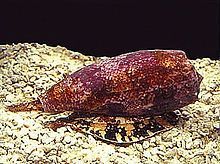Painkiller Made From Snail Venom Potentially 100 Times More Potent Than Morphine

A drug made from snail venom is showing early signs of success for pain management, according to researchers cited in an Agence France-Presse report.
The experimental drug, which has been tested on lab rats but not on humans, is considered to be about 100 times more potent than morphine or gabapentin, two drugs that are widely prescribed for alleviating chronic nerve pain. With its promising early test results, the new drug offers hope in the quest for non-addictive, overdose-proof pain meds, researchers reported Sunday.
The drug's active ingredient, conotoxin, comes from the carnivorous Coninae, or cone snail, which is prevalent in the western Pacific and Indian Ocean.
Cone snails hunt and immobilize prey using their modified radular tooth along with a poison gland containing neurotoxins. The tooth is launched out of the snail's mouth in a harpoon-like action. When the cone snail injects its venom, a fish can become paralyzed long enough for the snail to eat it, the Raw Story reported.
According to Agence France-Presse, another drug derived from conotoxin, ziconotide, has already been approved for use by humans. It's not available in pill form, but rather gets injected directly into the lower part of the spinal cord.
Lead researcher David Craik, of the University of Queensland in Australia, said a minuscule protein that comes from the snail's venom has formed the basis of five new experimental compounds.
A statement released prior to Craik's presentation at an American Chemical Society recent meeting in Dallas said a preliminary study using one of the compounds on lab rats showed it "appeared to significantly reduce pain."
"This is an important incremental step that could serve as the blueprint for the development of a whole new class of drugs capable of relieving one of the most severe forms of chronic pain that is currently very difficult to treat," Craik noted.
Animal venoms can block various channels in the nervous system, and perform in a different manner than morphine, hydrocodone and other opioid painkillers, which can be highly addictive and can lead to overdose.
In recent years, pharmaceutical firms have started to investigate venoms as potential sources of new drugs for managing neuropathic pain, which affects 15 percent of the U.S. population, and which can emerge because of cancer, diabetes, AIDS and other debilitating illnesses.
The five new compounds Craik and colleagues are developing would be taken orally. "We don't know about side effects yet, as it hasn't been tested in humans. But we think it would be safe," Craik said. Human trials are at least two years away, he added.
© Copyright IBTimes 2025. All rights reserved.





















